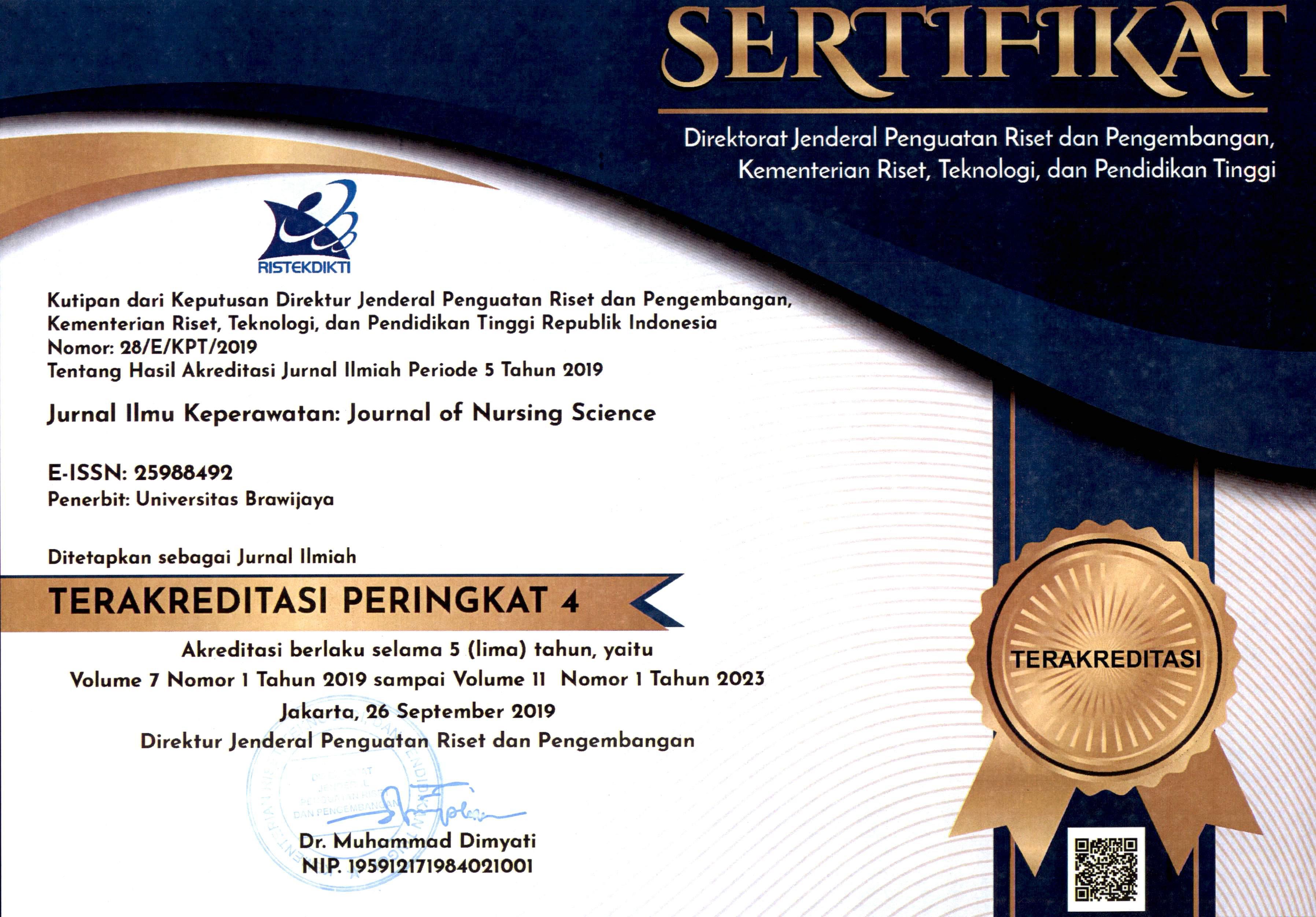RELATIONSHIP OF ORGANIZATIONAL COMMITMENT WITH PATIENT SAFETY INCIDENT REPORT CULTURE
DOI:
https://doi.org/10.21776/ub.jik.2018.006.02.2Keywords:
Organizational commitment, patient safety incident reportAbstract
Patient Safety Incident Report is one of indicator that has an important role in supporting the quality of patient safety. Because, Patient Safety Incident report can identify and reducing risks to patients who are harmed by treatment. One of the seven steps to achieving patient safety is organizational commitment. Organizational commitment is a commitment should be owned by the nurse in helping hospitals to achieve patient safety goals by involving themselves as evidence of loyalty to the organization in terms of patient safety incident report. This study aimed to find out the relationship between organizational commitment and the culture of Patient Safety Incident report of nurses in hospitals. The research design used was descriptive analytic correlation with cross sectional approach. The number of samples was 100 people. Data were analyzed using the chi-square test. Organizational commitment related significantly on patient safety incident report, p = 0.039. Nurses who have good organizational commitment have a high patient safety incident report 9%. Increasing organizational commitment owned by nurses can support the quality improvements, especially in the patient safety incident report. Giving rewards can be the alternative in increasing organizational commitment owned by nurses.
References
- Agency for Health Care Research and Quality. (2017). Patient Safety Primare: Culture of Safety. Retrieved from https://psnet.ahrq.gov/primers/primer/5/ culture-of-safety.
- Bowie, P. (2010). Leadership and implementing a safety culture. Journal Practice Nurse, 32-5.
- Hamdan, Z., Dalky, H., & Ramadneh, J. (2018). Nurses' professional commitment and its effect on patient safety. Global Journal of Health Science, 10(1), doi: 10.5539/gjhs.v10n1p111.
- Harsul, W., Syahrul, S., Majid, A. (2018). Penerapan budaya pelaporan insiden keselamatan pasien di sebuah Rumah Sakit Umum Daerah tipe B di Provinsi Sulawesi-Selatan. Jurnal Panrita Abdi, 2(2), 119-126.
- Hwang, H., & Lee YM. (2017). Effects of professional autonomy, organizational commitment, and perceived patient safety culture on patient safety management activities of nurses in medium and small-sized hospitals. Journal Korean Critical Care Nurse, 10(1), 63-74.
- Julianne, Morath, & Turnbull, J. (2005). To do no harm: Ensuring patient safety in health care organization. The New England Journal of Medicine, doi: 10.1056/NEJM200506303522625.
- Komite Keselamatan Pasien Rumah Sakit (KKPRS). (2015). Pedoman pelaporan insiden keselamatan pasien (IKP). Jakarta: KKPRS.
- Menteri Kesehatan Republik Indonesai (MKRI). (2011). Peraturan Menteri Kesehatan Republik Indonesia (cat. no. 1691). Jakarta, Indonesia: MKRI.
- NHS England. (2015). Patient safety incident reporting continues to improve. England: Author.
- Nygren, M., Roback, K., Ohrn, A., Rutberg, H., Rahmqvist, M., & Nilsen, P. (2013). Factors influencing patient safety in sweden: perceptions of patient safety officers in the county councils. BMC Health Services Research, 13(1), 52.
- Pohan, I. (2015). Jaminan mutu layanan kesehatan: dasar-dasar pengertian dan penerapan. Jakarta: EGC.
- Porter, L., Steers, R., Mowday, R., & Boulian, P. (1974). Organizational commitment, job satisfaction, and turnoveramong psychiatric technicians. Journal of Applied Psychology, 59(5), 603-609.
- Pronovost, P., Morlock, L., Sexton, J., Miller, M., Holzmueller, C., Thompson, D., . . . Albert. (2008). Improving the value of patient safety reporting system. Agency for Healthcare Research and Quality.
- Robbins, S., & Judge, T. (2013). Organizational Behavior (15th ed.). New Jersey: Person.
- RSUDZA. (2017). Pentingnya pelaporan insiden keselamatan pasien di rumah sakit. Aceh: RSUDZA.
- Sri, K. (2015). Hubungan Motivasi dan Komitmen Kerja Perawat dengan Penerapan Keselamatan Pasien di Ruang Intensif RSUP Sanglah Denpasar (Tesis, Universitas Udayana, Denpasar, Bali, Indonesia).
- Stow, J. (2006). Usng medical error reporting to drive patient safety efforts. Association of Operating Room Nurses, 405-408, 411-414, 417-420. doi: 10.1016/S0001-2092(06)63918-5.
- Tim RS RK Charitas Palembang. (2007). Menuju pelayanan kesehatan yang aman, kapita selekta keselamatan pasien di Rumah Sakit. Yogyakarta: Kanisius.
Downloads
Published
How to Cite
License
Authors published in this journal agree to the following terms:
1. The copyright of the received article shall be assigned to the journal as the publisher of the journal. The intended copyright includes the right to publish the article in various forms (including reprints). The journal maintains the publishing rights to the published articles.
2. Authors may enter into separate additional contractual agreements for the non-exclusive distribution of the published journal version of the work (for example, posting it to an institutional repository or publishing it in a book), with acknowledgment of their initial publication in this journal.
3. Authors are permitted and encouraged to post their work online (e.g. in an Institutional Repository or on their website) before and during the submission process, as this can result in a productive exchange, as well as earlier and larger citations of the published work.
4. Articles and all related material published are distributed under Creative Commons Attribution-NonCommercial 4.0 International License or CC BY-NC 4.0 license.
JNSU is licensed under a Creative Commons Attribution-NonCommercial 4.0 International License or CC BY-NC 4.0 license.
Most read articles by the same author(s)
- Liza Fauzia, Kadek Ayu Erika, Andi Masyitha Irwan, LITERATURE STUDY: VALIDITY AND RELIABILITY TEST OF MASLACH INSTRUMENTS BURNOUT INVENTORY-HUMAN SERVICES SURVEY (MBI-HSS) IN NURSES IN SEVERAL COUNTRIES , Journal of Nursing Science Update (JNSU): Vol. 7 No. 2 (2019)





























